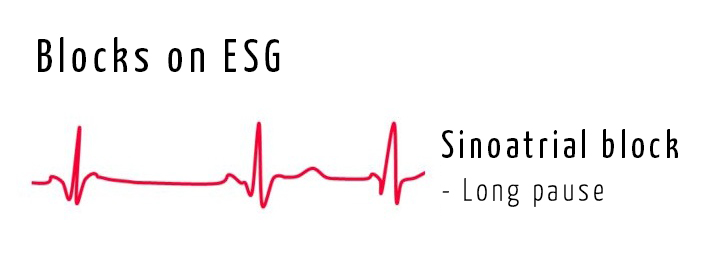Difference between revisions of "Sinoatrial block"
(Новая страница: «en:Sinoatrial block ru:Синоаурикулярная блокада справа<b>Sinoat…») |
|||
| (4 intermediate revisions by the same user not shown) | |||
| Line 1: | Line 1: | ||
[[en:Sinoatrial block]] | [[en:Sinoatrial block]] | ||
[[ru:Синоаурикулярная блокада]] | [[ru:Синоаурикулярная блокада]] | ||
| − | [[ | + | [[File:Sinoatrial_block.jpg|right]]<b>Sinoatrial block</b> is a form of intracardiac conduction disturbance characterized by retardation or complete cessation of impulse transmission from the [[sinus cardiac pacemaker|sinus node]] to the atria. Sinoatrial block is manifested by sensations of interruptions and fading of the heart, short-term dizziness, general weakness, development of the [[Morgagni-Adams-Stokes syndrome]]. Sinoatrial block is relatively rare in cardiology. According to statistics, this conduction disorder in men develops more often (65%) than in women (35%). Sinoatrial block can be detected at any age. Clinical manifestations of first-degree sinoatrial block are absent. The symptomatology of second-degree sinoatrial block depends on the frequency of dropping out of the sinus impulse. With rare dropping out of the heart contractions, there are feelings of discomfort behind the sternum, dizziness, shortness of breath, general weakness. |
The absence of several heart cycles in a row, as well as third-degree sinoatrial block, is accompanied by a feeling of fading of the heart, noise in the ears, a sharp [[bradycardia]]. In the case of sinoatrial block caused by an organic lesion of the myocardium, congestive heart failure develops. | The absence of several heart cycles in a row, as well as third-degree sinoatrial block, is accompanied by a feeling of fading of the heart, noise in the ears, a sharp [[bradycardia]]. In the case of sinoatrial block caused by an organic lesion of the myocardium, congestive heart failure develops. | ||
| − | Against the background of bouts of [[asystole]] in patients with sinoatrial block, Morgagni-Adams-Stokes syndrome develops, characterized by sudden dizziness, pallor of the skin, twinkle of flies before the eyes, ringing in the ears, loss of consciousness, convulsions. | + | Against the background of bouts of [[asystole]] in patients with sinoatrial block, the Morgagni-Adams-Stokes syndrome develops, characterized by sudden dizziness, pallor of the skin, twinkle of flies before the eyes, ringing in the ears, loss of consciousness, convulsions. |
| + | |||
| + | This pathology can be detected using ECG Dongle [https://cardio-cloud.ru/good/1] and ECG Dongle Full [https://cardio-cloud.ru/good/2]. | ||
Latest revision as of 12:28, 31 March 2021
Sinoatrial block is a form of intracardiac conduction disturbance characterized by retardation or complete cessation of impulse transmission from the sinus node to the atria. Sinoatrial block is manifested by sensations of interruptions and fading of the heart, short-term dizziness, general weakness, development of the Morgagni-Adams-Stokes syndrome. Sinoatrial block is relatively rare in cardiology. According to statistics, this conduction disorder in men develops more often (65%) than in women (35%). Sinoatrial block can be detected at any age. Clinical manifestations of first-degree sinoatrial block are absent. The symptomatology of second-degree sinoatrial block depends on the frequency of dropping out of the sinus impulse. With rare dropping out of the heart contractions, there are feelings of discomfort behind the sternum, dizziness, shortness of breath, general weakness.
The absence of several heart cycles in a row, as well as third-degree sinoatrial block, is accompanied by a feeling of fading of the heart, noise in the ears, a sharp bradycardia. In the case of sinoatrial block caused by an organic lesion of the myocardium, congestive heart failure develops.
Against the background of bouts of asystole in patients with sinoatrial block, the Morgagni-Adams-Stokes syndrome develops, characterized by sudden dizziness, pallor of the skin, twinkle of flies before the eyes, ringing in the ears, loss of consciousness, convulsions.
This pathology can be detected using ECG Dongle [1] and ECG Dongle Full [2].

